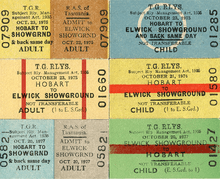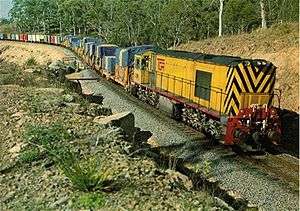Tasmanian Government Railways
 | |
|
TGR network map (at fullest extent) | |
| Locale | Tasmania, Australia |
|---|---|
| Dates of operation | 1871–1978 |
| Predecessor | Tasmanian Main Line Company |
| Successor | AN Tasrail |
| Track gauge | 3 ft 6 in (1,067 mm) |
| Headquarters | Launceston, Tasmania |
The Tasmanian Government Railways (TGR) was the former operator of the mainline railways in Tasmania, Australia. Formed in 1872, the railway company was managed by the Government of Tasmania, and existed until absorption into the Australian National Railways Commission in 1978.[1]
History
The early railways of Tasmania were initially constructed by a number of private companies, each using a differing gauge. In 1871, the Launceston and Western Railway (L&WR) opened the first railway line in Tasmania, with a 5 ft 3 in (1,600 mm) line from Launceston to Deloraine. The Tasmanian Main Line Railway Company (TMLR) later opened their Hobart to Evandale line in 1876, to a 3 ft 6 in (1,067 mm). Because of the break-of-gauge, the TMLR laid a third rail upon the L&WR line, and operated dual gauge for the final 11 miles (17.7 km) to Launceston.[2]
The Tasmanian Government Railways had already been established in 1872 after progressively taking over failed railway companies across the state, and as financial issues toiled the larger railway companies, the TGR took over the L&WR in 1888 and the TMLR in 1890, thus creating an official public railway service in Tasmania.[1] As a result of this takeover, all Tasmanian railways were relaid or newly constructed in 3 ft 6 in (1,067 mm) gauge.
In 1938, the railway administration was absorbed into the newly created Transport Commission and became its Railway Branch. The Commission was empowered to co-ordinate and improve land transport within the State, and one of its policies was to encourage the use of the railway wherever possible.[3]
In 1978 the Tasmanian government took up an offer by the Whitlam Federal Government to take over the state-owned railways, which resulted in the TGR being absorbed into the new Australian National Railways Commission, operating as Tasrail.[4]
Centenary
From February 7 to February 14, 1971, the TGR celebrated its centenary of operations, with special trains scheduled during this time for trips between Launceston and Deloraine with intermediate stops. Special fares were arranged for these trips, with return tickets between the two termini priced at $1.00 (approximately $9.74 in 2012). Trains were arranged with either single, double or triple-headed steam locomotives, depending on the type of stock and number of passengers carried.
On February 10, the official ceremony was held at Launceston Railway Station, with addresses from the Transport Commissioner Mr. G.T Webb and Minister for Transport the Hon. L.H Bessell MHA, as well as the unveiling of a commemorative plaque by the then-Premier of Tasmania William Angus Bethune.[5] Richard Green, the Mayor of Launceston, also presented the Guard of the centenary train with "Scrolls of Greetings", which were presented to the Wardens of the Municipalities of Evandale, Longford, Westbury and Deloraine. The Centenary Train also conveyed special mail from the Launceston Post Office, as well as politicians and invited guests.
After the Centenary train, further special trains were run through to St Marys on the Fingal Line, south down to Ross on the Main Line, and as far up as Railton on the Western line. Several trains were also timetabled to pick up passengers flown from Melbourne to Western Junction.[5]
The centenary celebrations were overall viewed as an astounding success, with most seats booked on each special train. Aside from the use of one Y Class diesel locomotive on a train for "special guests", every train scheduled as part of the centenary used well-maintained steam locomotives that were still in use on Tasmanian main lines.
Operations
With around 16 lines across the state,[6] the TGR operated a combination of approximately 275 stations, halts and junctions (as of 1949).[7] Large stations were located at Hobart, Derwent Park, New Norfolk, Parattah, Launceston, Zeehan, Burnie and Devonport.

On Hobart's suburban branch spurs, the TGR operated workers trains and freight for the Electrolytic Zinc Company and its zinc works in Lutana, as well as the Cadbury's Chocolate Factory in nearby Claremont. Special trains were also conveyed on Hobart's suburban network, with trains operating to Elwick Racecourse for the Hobart Cup, and to the Royal Hobart Showgrounds for the Royal Hobart Show. The special show trains to the Showgrounds ended in 1978, and were the last TGR passenger trains to be run in Tasmania.
In the 1970s, with the increase in car ownership, funding for highways and the loss of goods consignments, the TGR's operations suffered, and passenger services were eventually ceased across the network. Hobart suburban services ended in 1974, with passenger services ending entirely in 1978.
TGR introduced in 1954 some containers for bulk goods such as cement, sand, gravel and superphosphate.[8]
Network
- Main Line - Running North/South between Hobart and Launceston.
- Western Line - Running from Western Junction (near Launceston) to Wiltshire Junction.
- Derwent Valley Line - Running from Bridgewater Junction to logging areas in Florentine.
- Fingal Line - Branching from Conara Junction, south of Launceston, to St Marys on the East Coast.
- Irishtown-Trowutta Line - A short line from Irishtown Junction (outside Smithton) to rural areas southwards.
- Bell Bay Line - Opened in the early 1970s, this line connected Launceston to its northern port at Bell Bay.
- Apsley Line - Branching from Brighton Junction north into rural farmlands. Closed in 1947.
- Mole Creek Line - Branching from Lemana Junction south from the Western Line into logging areas. Closed 1985.
- Strahan-Zeehan Line - An isolated line joined to private railways, that linked the aforementioned West Coast towns.
- Bellerive-Sorell Line - An isolated and short-lived line that joined the Hobart suburb to the rural communities in the East. Closed in 1926.
Hobart Railway Station
The largest terminus in the state was built in Hobart in 1871 by the Tasmanian Main Line Company, and was further expanded in the 20th century, with the station reconstructed and modernised in 1950. After the completion of construction works, the station had four platforms and a large concourse, as well as shopping stalls and food vendors.
In the 1960s and early 1970s the railway station saw more than 70 trains a day come and go. With the gradual cessation of passenger services in the latter half of the 1970s and the takeover by Australian National Railways in 1978, the railway station was sold and redeveloped in the 1980s. Sections of track that went into the station were demolished for the extension of the Tasman Highway onto Davey Street and Macquarie Street, and today, the redeveloped site houses the studios of the Australian Broadcasting Corporation and the Bahá'í Centre of Learning, with the only remaining part of the rail terminal the original sandstone TMLR station building from 1871.[9]
Tasman Limited
The Tasman Limited was Tasmania's only named train. Inaugurated in April 1954, the train originally began as an express railcar service; however, later became a first-class luxury passenger service, operated with special articulated coaching stock, buffet service and modern X class diesel locomotives. Seating was reserved, and the service ran from Hobart to Wynyard with connections to Launceston, every day of the week except Sundays.
The Tasman, as it was colloquially known, outlasted all other TGR passenger services, and was officially the last regular scheduled government passenger train to operate on the Tasmanian rail network, departing Hobart at 9.20am on Friday July 28th, 1978.
Tasmanian Railway Institute
In the 1930s, the TGR formed the Railway Institute as a social and recreational branch for employees of the TGR and their families. Staffed by railway personnel, the TGR provided facilities to the Institute; with recreation halls and branches founded in Hobart, Launceston, Conara, Devonport and Wynyard. These halls contained offices, libraries, billiards rooms, a kitchen and other sporting and social facilities. The Launceston branch was unique, in that it also held a Commonwealth-recognised indoor small-bore rifle range, and boxing stadium.[10]
The Institute was tasked with training and certifying employees who were to be in charge of railway station accounts. The Institute also formed an intrastate sporting events calendar, with teams from each branch participating. More central branches (e.g. Hobart), because of the higher number of members, often fielded two or more teams.
As well as providing hall facilities, the Institute purchased several holiday homes located across Tasmania, as a way of providing members and their families with affordable holidays. A two-bedroom home at Scamander and a three-bedroom former station master's house at Claremont were initially acquired. The TGR also provided a six-bedroom house in both Stanley and Devonport, and later a house in Wynyard and South Burnie were also requisitioned. In 1978 when passenger services and the TGR ceased, employee numbers fell and subsequently the houses in Stanley, Wynyard and South Burnie were abandoned. Railway Institute facilities were also sold off, and the halls in Devonport and Wynyard were the last to be sold; with Devonport selling just prior to the sale of AN Tasrail to the private consortium ATN TasRail.[10]
Today, the Railway Institute still remains, but is now known as the AN (Railway) Institute of Tasmania Inc.. Several holiday homes also still exist and are in use, with the house in Devonport having been retained from TGR days. Two units in St Helens and two units in Claremont are also available, as well as a three-bedroom house in Launceston which was attained from AN Tasrail after they vacated offices there. These are owned outright by the Institute, after in the 1980s during the time of the Australian National Railways Commission's ownership, a Master of Operating lease was created to prevent future railway administrations from taking away Institute facilities.
Due to legal threats from the state government, however; the Institute was made to purchase the outstanding equity in the holiday homes of the TGR, to become completely separate to the railway administration. The Tasmanian membership paid $100,000 and the national administration of the ANR Railway Institute borrowed some more to buy the railway's equity in St Helens, Launceston, Devonport and Hobart. In 1997, the Institute in Tasmania became almost autonomous and became administered by volunteers. The Institute in Tasmania is assisted in administration by the board of AN Institute Inc. and its staff in Port Augusta, South Australia.[10]
Rollingstock

The Tasmanian Government Railways had a vast range of motive power and rollingstock, including many steam and latterly diesel locomotives and railmotors. Throughout the history of the TGR, the company set a number of milestones in railways, including being the first operator of mainline diesel locomotives in Australia,[11] and being the first in the world to operate a Garratt locomotive.
The passenger rollingstock of the TGR included the 1955-58 series ACS class 'articulated country saloons', 76-seat first class with air suspended reclining seats, tray tables, state-of-the-art lighting and heating, and buffet service with hostesses. To the end in 1978, the TGR still used AAL class first class saloons with leather seats and maple panelling, as well as SP class brake and 2nd class passenger carriages, converted from Sentinel steam railcars.
When TGR was abolished in 1978, most rollingstock was transferred onto the register of Australian National Railways (with the exception of all passenger stock other than that kept for departmental use).
Locomotives
The TGR had a large and varying fleet of both steam (and diesel in 1950) locomotives, and many served a multi-purpose position in the system; hauling freight, passenger, and mixed trains. The company also had a fleet of railcars used for inter-suburban commuter services.
Diesel
- V class[12]
- X class (introduced 1950, first mainline diesel locomotive in Australia)
- Y class (introduced 1961)
- Z class (introduced 1973)
- Za class (introduced 1973)

Railcars
- TGR DP class (introduced 1939)
These railcars were built by Waddingtons and served the Hobart-Parattah regional and suburban services up until 1974.
Steam
- TGR M/MA class (introduced 1952/1957)
- TGR H class (introduced 1951)
- TGR F class (introduced 1949)
- TGR G class (introduced 1944-50)
- TGR DS class (introduced 1939-44)
- TGR CCS class (introduced 1924)
- TGR Q class (introduced 1922)
- TGR M class (introduced 1912)
- TGR L class (introduced 1912)
- TGR CC class (introduced 1912)
- TGR K class (introduced 1909, first Garratt in the world)
- TGR G class[13](introduced 1896)
- TGR C class (introduced 1885-1937)
Preservation
Much of the TGR's former rollingstock and traction has been preserved by enthusiast groups and museums, or have been placed in public parks in Tasmania. The Tasmanian Transport Museum,[14] Don River Railway[15] and Derwent Valley Railway[16] all hold extensive collections of TGR-related ephemera, infrastructure and rollingstock; either operational or non-operational/unrestored. The Queen Victoria Museum and Art Gallery, which is housed in the former TGR locomotive workshops in Inveresk, Tasmania, hold examples of the TGR's industrial operations, as well as a Y class locomotive, wagons, and locomotive nameplates and builder's plates.[17] The Bellarine Railway in Queenscliff, Victoria, also has a number of ex-TGR carriages and locomotives.[18]
During the 1980s, the Hotham Valley Tourist Railway (HVR) south of Perth, Western Australia, purchased a V-class diesel-mechanical shunt locomotive and several ex-Tasman Limited passenger carriages.
A couple of steam locomotives have been plinthed over the years and used in public parks since their withdrawal, with MA3 placed at the markets in Margate, and H6 placed at a park in Perth.[19]
Internationally, a handful of TGR locomotives still remain, with the first Garratt, K1, surviving at the Welsh Highland Railway in Wales;[20] and M2, an M class Pacific steam locomotive, which was moved from a park in Stanley in 1984, now remains at the Tanfield Railway in County Durham, England; however, this locomotive remains derelict and unrestored, and its future is uncertain.[21]
See also
References
- 1 2 "Tasmanian Government Railways". LINC Tasmania. Retrieved 2012-06-12.
- ↑ "The Companion to Tasmanian History - Railways". Centre for Tasmanian Historical Studies: University of Tasmania. Retrieved 2012-06-12.
- ↑ "Transport Commission – Railway Branch". LINC Tasmania. Retrieved 2012-06-12.
- ↑ =Department of Infrastructure, Transport, Regional Development and Local Government. "Background - Organisation of Australia's Railways". www.infrastructure.gov.au. Retrieved 2010-06-22.
- 1 2 "Timetable and Programme: Centenary Trains and Official Day (Feb. 10th)". Tasmanian Government Railways. Retrieved 9 June 2013.
- ↑ "Railway Line information". RailTasmania.com. Retrieved 10 June 2013.
- ↑ "Stations list - 1949 Appendix". Tasmanian Government Railways - "Appendix to the Book of Rule and Regulations and Working Time Table". RailTasmania.com. Retrieved 10 June 2013.
- ↑ "TO CARRY CEMENT.". The Mercury (Hobart, Tas. : 1860 - 1954). Hobart, Tas.: National Library of Australia. 6 October 1954. p. 3. Retrieved 26 October 2011.
- ↑ Cooper G, Goss G (compilers). Tasmanian Railways 1871-1996; 125 years. Devonport: CG publishing Co. ISBN 0-646-27633-6.
- 1 2 3 "History". Railway Institute in Tasmania. AN (Railway) Institute of Tasmania Inc. Retrieved 28 September 2013.
- ↑ "Tasmanian Locomotives - X & XA Class". www.railtasmania.com. Australian Railway Historical Society (Tasmanian Division). Retrieved 8 June 2013.
- ↑ TGR V/VA class (introduced 1948)
- ↑ (introduced 1896)
- ↑ "Railway Exhibits". Tasmanian Transport Museum. Retrieved 10 June 2013.
- ↑ "Steam & Diesel Locomotives & Railcars". Don River Railway. Retrieved 10 June 2013.
- ↑ "Derwent Valley Railway". Derwent Valley Railway (Tasmania). Retrieved 11 July 2013.
- ↑ "Museum Attractions". http://www,qvmag.tas.gov.au. Queen Victoria Museum and Art Gallery. Retrieved 11 July 2013. External link in
|work=(help) - ↑ "National Collection". http://www.bellarinerailway.com.au. Bellarine Railway. Retrieved 11 July 2013. External link in
|work=(help) - ↑ "Tasmanian Government Railways". Australian Steam - Preserved Steam Locomotives Down Under. Australian Steam. Retrieved 10 June 2013.
- ↑ Armstrong, Laurence. "K1: The Original Garratt - Maintenance and Support". http://www.whrsoc.org.uk. Welsh Highland Railway Society. Retrieved 11 July 2013. External link in
|work=(help) - ↑ Dennis, M. "A Little Light Pacific History: The M2 story". Australian Steam. Retrieved 10 June 2013.
| Preceded by Various private companies |
Rail transport in Tasmania 1888-1978 |
Succeeded by AN Tasrail |
.png)